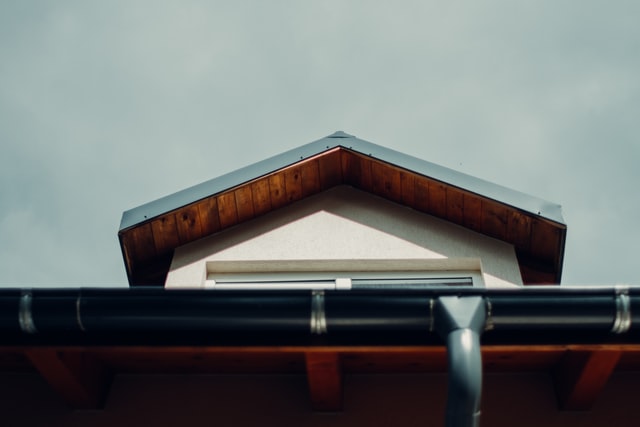
You can’t see what’s inside your gutters from the ground. If you do notice leaves or pine straw sticking out, they might be full of debris. It’s a good idea to inspect and clean your gutters regularly. But many homeowners wonder how often they should clean their gutters. The answer depends on how quickly the gutters get dirty.
General Guidelines for Gutter Cleaning Frequency
We recommend that most homeowners clean their gutters at least twice a year. If you’re wondering what time of year to clean your gutters, spring and fall are ideal.
However, you should take into account the particulars of your location and climate when deciding how often to clean your gutters. If you live in a forested area or have several trees towering over your house, you might have to clear organic debris more frequently.
How often you should clean your gutters is also based on the precipitation in your area. If you live in an area with a rainy season, make sure that the gutters are clear before the rains hit. Unclogging them before a snowy winter will safeguard your property from snow damage.
The best way to determine how often to clean your gutters is to keep an eye on them. If you can inspect them easily by looking out a window or using a ladder, head up there once or twice a season to check on them. You’ll get a sense of how quickly they fill up and can set a cleaning schedule accordingly.
Why Should You Clean Your Gutters at All?
Your gutters are vital for proper roof drainage. They allow precipitation to flow freely, diverting it from your home and foundation. If your gutters don’t work properly, they can cause water to build up, creating potential problems. Some of the issues that occur when you don’t clean your gutters include the following.
Pest Problems
Birds, rodents and other pests love to make nests in clogged gutters. The debris and the walls of the gutter provide a safe place for them to nest. If you have pests living in your gutters, it’s only a matter of time until they begin to intrude inside your home.
Moreover, animal nests can further block water flow, amplifying moisture issues. A damp environment is ideal for many pests, and you could experience insect infestations if your clogged gutters are causing water damage inside the home.
Leaks
Clogged gutters don’t let water escape quickly. As the moisture builds up, it can create pools and puddles on your roof. In addition, the wooden boards to which your gutters are mounted may absorb some of the standing water. This introduces water into the structure of your home, causing damage to the interior or exterior.
Some signs of water leakage include:
- Stains on the walls and ceilings
- Cracks in the drywall
- Wet spots or drips on the walls, ceilings or floors
- Water spots under the roof line outdoors
If you notice any of these indicators of a leak, have your roof checked out immediately. By the time you notice the problem, some damage has already been done.
Broken Gutters
The weight of the water that gets trapped among the debris in your gutters can build up quickly. This compromises the security of the gutters. With every gallon of water weighing eight pounds, the pressure can build up quickly.
Trapped water can make the seams in the gutters rupture. In addition, it can cause the entire gutter to pull away from the house. Sometimes, the weight of the water makes the gutters sag, which impairs their ability to drain water correctly.
Wet Basement
If your basement is wet or flooded, you might not think to look to your roof for the solution. But clogged gutters could be the culprit. When the gutters don’t reroute water away from the home, the rain that dribbles from every inch of your eaves creates a trench around the foundation. As water pools in that spot, it can seep down, causing leakage in your basement.
Mold and Mildew Growth
Drainage problems that aren’t corrected quickly lead to mold and mildew growth. This is especially a problem in warm, humid areas. Fungal growth on your roof or walls is not always easy to get rid of. If you don’t fix the source of the problem, the moisture accumulation will keep causing mold and mildew issues.
Besides being unsightly, mold and mildew growth can eat away at the material on which it grows. It can damage your home. It can also trigger allergies and health problems in the people and pets that live in your house.
How to Clean Your Gutters
Gutter cleaning isn’t rocket science. However, it does require knowledge of safety measures and some basic equipment.
Here are four ways to clean your gutters:
- By hand – Pull a ladder up to your gutters, and grab some garden gloves and a hand trowel. Collect the debris by hand or with the trowel, placing it in a bucket as you go.
- Blower method – Use the nozzle on your leaf blower to drive the debris out of the gutters. You may need to stand on a ladder for this. Cover the holes to the downspouts so that they don’t get clogged.
- Telescoping gutter cleaner – Clean the gutters from the ground by attaching this instrument to your hose.
- Wet/dry vacuum – Some industrial shop vacuums come with a hose that will help you access the gutters. Suck out the material if it’s not too bulky.
Always start at the spot closest to the downspout. Move down the length of the gutter before returning to the starting point. After you remove the largest pieces, flush the gutters with a hose to get rid of any particles that remain.
With the equipment above, you can easily and quickly clean your gutters without making it a dreaded chore. Plus, the more frequently you tackle this task, the easier it will be.
